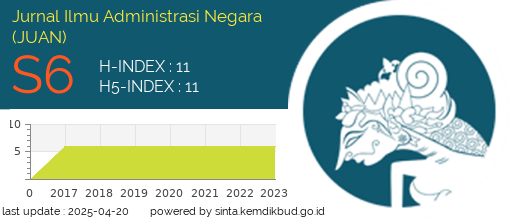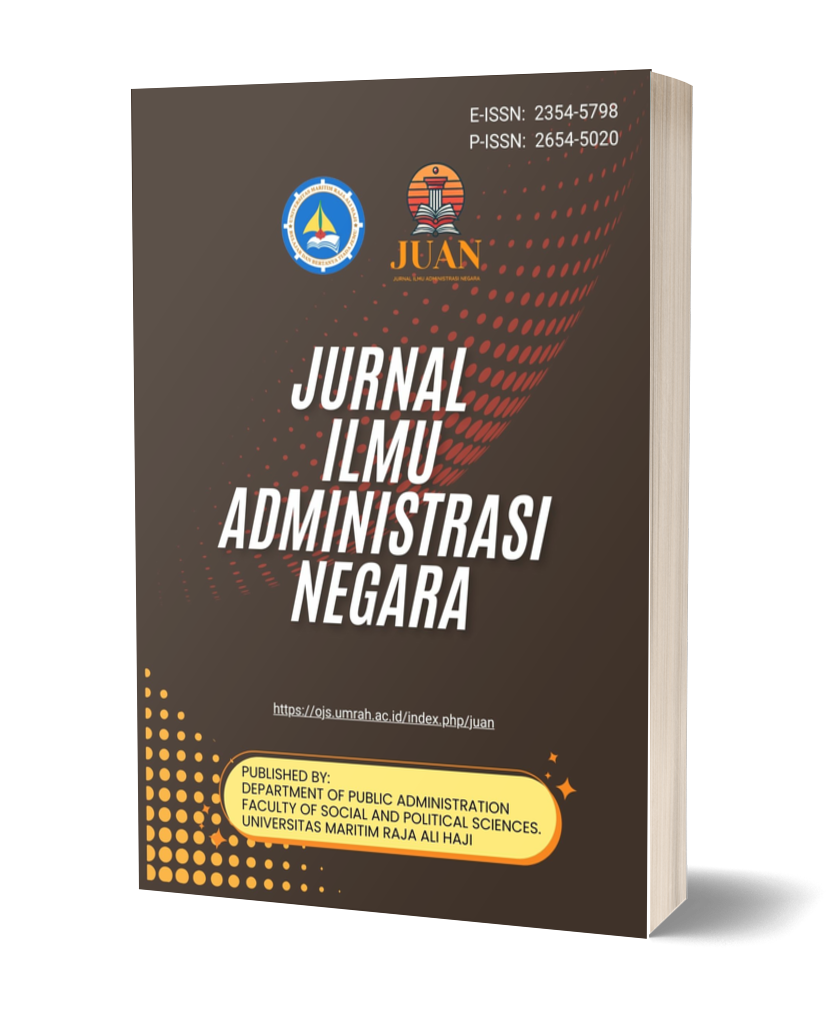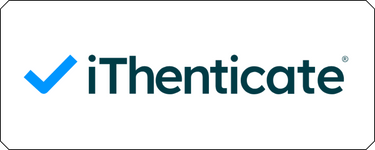FAKTOR-FAKTOR PENDORONG DAN PENGHAMBAT IMPLEMENTASI INOVASI SEKTOR PUBLIK DI KOTA PADANG PANJANG
DOI:
https://doi.org/10.31629/juan.v10i02.5166Keywords:
Innovation, Driving Factor, Barrier Factor, Padang Panjang CityAbstract
The COVID-19 pandemic has had an impact on access to public services. The Padang Panjang City Government, in collaboration with the State Administration Institute, held an Innovation Laboratory activity. This activity aims to ensure that the Padang Panjang City Government can continue to provide services to the community despite the pandemic. However, the Innovation Laboratory activities not running well. This study aims to analyze the factors driving and inhibiting the implementation of innovation in the city of Padang Panjang. This research is descriptive qualitative research. The research was at the Office of the Planning, Research, and Development Agency (Bappedalitbang) of Padang Panjang City. The researcher collects data through in-depth interviews, documentation, and literature studies. informan was chosen by using a purposive sampling technique, namely innovators who have produced innovations from each OPD of Padang Panjang City. The data analysis technique uses selecting, compiling, and drawing conclusions. This study's results found the driving factors, namely the support of the Regional Head, align with regional mission, clear SOPs / technical guidelines, knowledge transfer of innovation, and stakeholder involvement. Meanwhile, the limited number of innovation managers, the limited ability of innovation managers, and the mutation/rotation of employees who are competent towards innovation become barriers factors.
Downloads
References
Amin, R. M., Febrina, R., & Wicaksono, B. (2021). Handling COVID-19 from a Collaborative Governance Perspective in Pekanbaru City. Jurnal Bina Praja, 1–13. https://doi.org/10.21787/jbp.13.2021.1-13
Aminah, S., & Wardani, D. K. (2018). Readiness Analysis of Regional Innovation Implementation. Jurnal Bina Praja, 10(1), 13–26. https://doi.org/10.21787/jbp.10.2018.13-26
Asmara, A. Y., & Rahayu, A. Y. S. (2019). Inovasi Pelayanan Kesehatan Gancang Aron di Kabupaten Banyuwangi dalam Perspektif Matrik Inovasi Sektor Publik. JPSI: Journal of Public Sector Innovations, 3(2), 57–67. https://journal.unesa.ac.id/index.php/jpsi/article/view/4490
Bappeda Padang Panjang. (2020). Inovasi Unggulan Kota Padang Panjang.
Baptista, N., Alves, H., & Matos, N. (2020). Public Sector Organizations and Cocreation With Citizens: A Literature Review on Benefits, Drivers, and Barriers. Journal of Nonprofit & Public Sector Marketing, 32(3), 217–241. https://doi.org/10.1080/10495142.2019.1589623
Cinar, E., Trott, P., & Simms, C. (2019). A systematic review of barriers to public sector innovation process. Public Management Review, 21(2), 264–290. https://doi.org/10.1080/14719037.2018.1473477
Cinar, E., Trott, P., & Simms, C. (2021). An international exploration of barriers and tactics in the public sector innovation process. Public Management Review, 23(3), 326–353. https://doi.org/10.1080/14719037.2019.1668470
Damanik, M. I., Agustine, T. E., Prawira, M. Y., Rheza, B., & Febryanti, N. A. (2016). Penyederhanaan Perizinan Usaha di Daerah. https://media.neliti.com/media/publications/263-ID-penyederhanaan-perizinan-usaha-di-daerah.pdf
Dewi, I. A. R. K. (2020). Inovasi Pelayanan Publik “Sapaku Malam” di Kecamatan Kuta Utara, Kabupaten Badung. Public Inspiration: Jurnal Administrasi Publik, 5(2), 104–120. https://www.ejournal.warmadewa.ac.id/index.php/public-inspiration/article/view/3017/2159
Edo, D. H. A. P., & Mutiarin, D. (2018). Analisis Best Practice Inovasi Pelayanan Publik (Studi pada Inovasi Pelayanan “Kumis MbahTejo” di Kecamatan Tegalrejo Kota Yogyakarta). Jurnal Manajemen Pelayanan Publik, 1(2), 156–167. http://jurnal.unpad.ac.id/jmpp/article/view/16753/9215
Enciso-Santocildes, M., Vidu, A., & Gómez-Urquijo, L. (2020). Drivers for a cross-sector successful collaboration: the Basque country model of action. International Journal of Social Economics, 47(2), 268–284. https://doi.org/10.1108/IJSE-06-2019-0378
Febriyan, E. D., Wahyu Pradana, G., & Yuyun Eka Kartika Sari, dan. (2019). Digital Inovasi Sektor Publik: Efektivitas Kolaborasi dalam Implementasi Inovasi Desa Digital. Jurnal El-Riyasah, 10(2), 127–145. http://ejournal.uin-suska.ac.id/index.php/elriyasah/article/view/8909
Gardner, K. L., Dowden, M., Togni, S., & Bailie, R. (2010). Implementation Science Understanding uptake of continuous quality improvement in Indigenous primary health care: lessons from a multi-site case study of the Audit and Best Practice for Chronic Disease project. Implementation Science, 5(21). https://doi.org/https://doi.org/10.1186/1748-5908-5-21
Hamirul, H.-. (2019). Patologi Birokrasi Dalam Pelayanan Pemerintah (Studi pada Kantor Pertanahan Kota Cimahi). Jurnal Ilmu Administrasi Negara (JUAN), 7(2), 91–100. https://doi.org/10.31629/juan.v7i2.1439
Herwanto, T. S. (2015). Pentingnya Komitmen Penuh Organisasi dan Stakeholders dalam Mewujudkan Inovasi Publik. JIAP (Jurnal Ilmu Administrasi Publik), 1(2), 18–26. http://repository.unpar.ac.id/handle/123456789/1191
Hossain, M. Z., & Yasmin, T. (2022). Factors affecting public sector innovation during COVID-19 pandemic in Bangladesh: an analysis on three cases. International Review of Public Administration, 27(1), 1–14. https://doi.org/10.1080/12294659.2022.2044105
Hutagalung, S. S., & Hermawan, D. (2018). Evaluation of Local Government Innovation Program in Lampung Province. Jurnal Bina Praja, 10(2), 241–250. https://doi.org/10.21787/jbp.10.2018.241-250
Ibidunni, A. S., Kolawole, A. I., Olokundun, M. A., & Ogbari, M. E. (2020). Knowledge transfer and innovation performance of small and medium enterprises (SMEs): An informal economy analysis. Heliyon, 6(8). https://doi.org/10.1016/j.heliyon.2020.e04740
Kellogg, W. K. (2004). Using Logic Models to Bring Together Planning, Evaluation, and Action. https://www.naccho.org/uploads/downloadable-resources/Programs/Public-Health-Infrastructure/KelloggLogicModelGuide_161122_162808.pdf
Kevaladandra, Z., & Martha, E. (2021). Dampak COVID-19 Terhadap Pelayanan KIA Di Kota Cilegon. Jurnal Keperawatan Muhammadiyah, 6(2), 10–16. http://103.114.35.30/index.php/JKM/article/view/7776
LAN. (2018). Pedoman Penyelenggaraan Laboratorium Inovasi.
LAN. (2021). Laboratorium Inovasi. https://lan.go.id/?p=5431
Lewis, J. M., Ricard, L. M., & Klijn, E. H. (2018). How Innovation Drivers, Networking and Leadership Shape Public Sector Innovation Capacity. International Review of Administrative Sciences, 84(2), 288–307. https://doi.org/10.1177/0020852317694085
Melinda, M., Syamsurizaldi, S., & Kabullah, M. I. (2020). Inovasi Pelayanan Administrasi Kependudukan Online (Paduko) oleh Dinas Kependudukan dan Pencatatan Sipil Kota Padang Panjang. Nakhoda: Jurnal Ilmu Pemerintahan, 19(2), 202–216. https://doi.org/10.35967/njip.v19i2.115
Mergel, I. (2018). Open innovation in the public sector: drivers and barriers for the adoption of Challenge.gov. Public Management Review, 20(5), 726–745. https://doi.org/10.1080/14719037.2017.1320044
Miles, M. B., Huberman, A. M., & Saldana, J. (2014). Qualitative Data Analysis: A Methods Source Book (3th ed.). SAGE Publication.
Nadolna, K. K., & Beyer, K. (2021). Barriers to Innovative Activity in The Sustainable Development of Public Sector Organizations. Procedia Computer Science, 192, 4376–4385. https://doi.org/10.1016/j.procs.2021.09.214
Natário, M. M., & Couto, J. (2022). Drivers, Enablers, and Conditions for Public Sector Innovation in European Countries. In Innovar (Vol. 32, Issue 83). Universidad Nacional de Colombia. https://doi.org/10.15446/innovar.v32n83.99255
OECD, & Eurostat. (2018). OSLO Manual 2018: Guidelines for Collecting, Reporting and Using Data on Innovation, 4th Edition, The Measurement of Scientific, Technological and Innovation Activities (4th ed.). OECD Publisher. https://doi.org/10.1787/9789264304604-en
Palm, K., & Algehed, J. (2017). Exploring enablers of innovative quality development in public administration. International Journal of Quality and Service Sciences, 9(2), 203–217. https://doi.org/10.1108/IJQSS-03-2016-0021
Pradana, I. P. Y. B., Susanto, E., & Kumorotomo, W. (2022). Analyzing the critical factors for innovation sustainability in the public sector: evidence from Indonesia. International Journal of Public Sector Management. https://doi.org/10.1108/IJPSM-02-2022-0044
Prastya, Y. R., & Sunaningsih, S. N. (2020). Analisis Penerapan Program Inovasi Pada Disdukcapil Kota Magelang Tahun 2020. Jurnal Ilmu Administrasi Negara (JUAN), 8(2), 122–132. https://doi.org/10.31629/juan.v8i2.2686
Purnamasari, A. I., Wardani, Y. I., & Hidayah, D. A. (2020). INOVASI LAYANAN TRANSAKSI E-GOVERNMENT PADA BIDANG PERIZINAN TERPADU KOTA MALANG. Prosiding Simposium Nasional.
Rafinzar, R. (2020). Inovasi E-Government Dalam Pelayanan Publik (Studi Faktor Pendukung Dan Penghambat Program E-Musrenbang Kota Surabaya). Jurnal Administrasi Publik, 6(2), 228–250. https://36.89.54.123/index.php/kolaborasi/article/view/3959
Rohman, A., & Larasati, D. C. (2020). Standar Pelayanan Publik di Era Transisi New Normal. Reformasi : Jurnal Ilmiah Ilmu Sosial Dan Ilmu Politik, 10(2), 151–163. https://doi.org/10.33366/rfr.v%vi%i.1952
Safitri, E., Reginaldis, M. M., & Dumatubun, N. F. M. L. (2021). Implementasi Inovasi Samsat Delivery Dalam Meningkatkan Mutu Pelayanan Publik Pada Kantor Bersama Samsat Merauke. Jurnal Administration and Public Service, 2(1), 12–27. http://ejurnal.ung.ac.id/index.php/jjaps/index
Sinurat, H. P., & Sumanti, R. (2020). Tantangan Penerapan Inovasi di Kota Sabang. Spirit Publik, 15(1), 39–49. https://jurnal.uns.ac.id/spirit-publik/article/view/37903/27288
Sofianto, A. (2019). Inovasi Manajemen Pemerintahan Berbasis Aplikasi Digital di Provinsi Jawa Tengah. Matra Pembaruan, 3(2), 99–108. https://doi.org/10.21787/mp.3.2.2019.99-108
Sørensen, E., & Torfing, J. (2012). Collaborative Innovation in the Public Sector. The Innovation Journal: The Public Sector Innovation Journal, 17(1), 1–14. https://www.innovation.cc/volumes-issues/2012_17_1_1_eva_sorensen_torfing_intro.pdf
Srimarchea, D. W., & Aziza, T. N. (2021). Penumbuh-kembangan Inovasi Melalui Laboratorium Inovasi Bagi Pemerintah Daerah di Indonesia. INOVASI: Jurnal Politik Dan Kebijakan, 18(2), 169–177. https://doi.org/https://doi.org/10.33626/inovasi.v18i2.414
Sudrajat, A., & Andhika, L. (2021). Empirical Evidence Governance Innovation in Public Service. Jurnal Bina Praja, 13(3), 407–417. https://doi.org/10.21787/jbp.13.2021.407-417
Sugiyono. (2013). Metode Penelitian Pendidikan Pendekatan Kuantitatif, Kualitatif, dan R&D. Alfabeta.
Suwarno, Y. (2008). Inovasi di Sektor Publik. STIA-LAN Press. https://zerosugar.files.wordpress.com/2012/04/e-book-inovasi-di-sektor-publik-yogi-suwarno.pdf
Torfing, J. (2019). Collaborative innovation in the public sector: the argument. Public Management Review, 21(1), 1–11. https://doi.org/10.1080/14719037.2018.1430248
Torvinen, H., & Jansson, K. (2022). Public health care innovation lab tackling the barriers of public sector innovation. Public Management Review. https://doi.org/10.1080/14719037.2022.2029107
Urquhart, R., Kendell, C., Cornelissen, E., Powell, B. J., Madden, L. L., Kissmann, G., Richmond, S. A., & Bender, J. L. (2021). Identifying factors influencing sustainability of innovations in cancer survivorship care: A qualitative study. BMJ Open, 11(2). https://doi.org/10.1136/bmjopen-2020-042503
Utomo, T. W. W. (2018). Inovasi Harga Mati (1st ed.). Rajagrafindo Persada.
Warsaw School of Economics. (2015). Poland Competitiveness Report 2015: Innovation and Poland’s Performance in 2007-2014 (Patricia Koza & Grzegors Siwicki, Eds.; 1st ed.). Warsaw School of Economics Press. https://ssl-kolegia.sgh.waw.pl/pl/KGS/struktura/IGS-KGS/publikacje/Documents/poland_competitiveness_report_2015.pdf#page=241
Widodo, S., Marpaung, Z. S., & Santoso, A. D. (2022). What Makes Public Sector Innovation Sustainable?: A Case Study from Indonesia. TEM Journal, 11(3), 1376–1384. https://doi.org/10.18421/TEM113-48
Wipulanusat, W., Panuwatwanich, K., Stewart, R. A., & Sunkpho, J. (2019). Drivers and barriers to innovation in the Australian public service: A qualitative thematic analysis. Engineering Management in Production and Services, 11(1), 7–22. https://doi.org/10.2478/emj-2019-0001
Zica, T. D., & Fanida, E. H. (2022). Inovasi Pelayanan Administrasi Kependudukan Melalui Aplikasi PANDU CAKTI di Kantor Dispendukcapil Kabupaten Tulungagung. Publika, 10(2), 487–498. https://ejournal.unesa.ac.id/index.php/publika/article/view/45193
Downloads
Published
Issue
Section
License
You are free to:
- Share — copy and redistribute the material in any medium or format for any purpose, even commercially.
- Adapt — remix, transform, and build upon the material for any purpose, even commercially.
- The licensor cannot revoke these freedoms as long as you follow the license terms.
Under the following terms:
- Attribution — You must give appropriate credit, provide a link to the license, and indicate if changes were made . You may do so in any reasonable manner, but not in any way that suggests the licensor endorses you or your use.
- ShareAlike — If you remix, transform, or build upon the material, you must distribute your contributions under the same license as the original.
- No additional restrictions — You may not apply legal terms or technological measures that legally restrict others from doing anything the license permits.













